Kenwood USA 383200 VHF/UHF FM/AM Handheld/Portable/Mobile Tranceiver User Manual
Kenwood USA Corporation VHF/UHF FM/AM Handheld/Portable/Mobile Tranceiver
User Manual

© B62-1976-00 (K)
09 08 07 06 05 04 03 02 01 00
UHF FM TRANSCEIVER
TK-3230
INSTRUCTIoN MANUAl
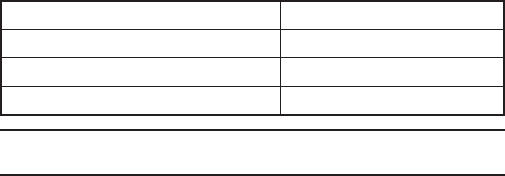
Thank You
We are grateful for your purchase of this Kenwood product
and welcome you to the Business Radio Service (BRS). Your
Kenwood 2-way Business Radio is called a “transceiver”,
meaning “transmitter & receiver”. We believe this easy-to-use
transceiver will provide you with dependable and reliable
communications. This Kenwood transceiver is a precision
device. Treat it with care, and you will enjoy years of reliable
operation.
FeaTures
• Lightweight and compact design using a lithium-ion battery pack,
with a sturdy, polycarbonate body and a spring-loaded belt clip.
• 122 tone/code settings for each channel, allowing you to ignore
unwanted calls.
• Privacy Talk scrambles all your voice messages, giving you
complete privacy for your conversations.
• FleetSync operation, allowing a variety of call types.
• Automatic battery power saver, providing you with longer battery
usage.
• Battery power level indicator with low battery power warning.
• Key lock and Super Lock prevent you from accidentally changing
your transceiver settings.
• Ten different calling alert tones allows you to identify yourself to
your group before you begin speaking.
• Hands free operation when using an optional headset.
operaTing CondiTions
Open locations (no obstructions) Up to 4 miles (6.4 km)
Residential areas (near buildings) Up to 1.5 miles (2.4 km)
In steel/ concrete reinforced buildings
Up to 200,000 ft2 (18,580 m2)
In high rises Up to 15 oors
Note: The listed ranges are based on eld testing and may vary
with your operating conditions.
i
FCC LiCense inFormation
Your Kenwood radio operates on communications frequencies
which are subject to FCC (Federal Communications
Commission) Rules & Regulations. FCC Rules require that all
operators using Private Land Mobile radio frequencies obtain a
radio license before operating their equipment. Application for
license must be made on FCC form 601.
FAX: Forms can be obtained by fax from the FCC
Fax-On-Demand system. Call 1-202-418-0177 from your
fax machine to request the documents.
MAIL: Forms can be ordered by telephone, and will be sent to
1-800-418-FORM (1-800-418-3676).
INTERNET: Form 601 and instructions can be downloaded
from the FCC Forms website at:
http://www.fcc.gov/formpage.html
section, you must decide which frequency (or frequencies) you
will operate on. Refer to the frequency chart on page 44.
Questions? Call the FCC for license application questions at
1-888-CALL-FCC (1-888-225-5322).
ChanneL spaCing
xls
spacing may not have optimal sound quality when used with
ii
notiCes to the User
subject to the following two conditions:
(1) this device may not cause harmful interference, and
(2) this device must accept any interference received, including
interference that may cause undesired operation.
One or more of the following statements may be applicable:
FCC WARNING
INFORMATION TO THE DIGITAL DEVICE USER REQUIRED BY THE FCC
limits are designed to provide reasonable protection against harmful
interference in a residential installation.
energy and, if not installed and used in accordance with the
instructions, may cause harmful interference to radio communications.
in a particular installation. If this equipment does cause harmful
interference to radio or television reception, which can be determined
by turning the equipment off and on, the user is encouraged to try to
correct the interference by one or more of the following measures:
• Reorient or relocate the receiving antenna.
• Increase the separation between the equipment and receiver.
• Connect the equipment to an outlet on a circuit different from that to
which the receiver is connected.
• Consult the dealer for technical assistance.

iii
SAFETY INFORMATION:
Your wireless hand-held portable transceiver has been designed using
a low power transmitter.
When the PTT switch is pressed, the transceiver generates radio
frequency (RF) electromagnetic energy (EME).
FCC 96-326 (August, 1996).
• Do not transmit for more than 50% of the total operating time.
the LED that lights red while transmitting.
2 inches (5 cm) from your head and body.
• When using a headset, ensure that the antenna is at least
2 inches (5 cm) away from your body whenever you are
transmitting.
• Use only Kenwood
violate FCC rules and regulations.
ATTENTION (U.S.A. Only):
Kenwood
Kenwood
program to collect and recycle Li-ion batteries
program is an alternative to disposing Li-ion
batteries with your regular refuse or in municipal
waste streams, which is illegal in some areas.
For information on Li-ion battery recycling in your area, call (toll free)
Kenwood
preserve our environment and conserve our natural resources.

iv
• Government law prohibits the operation of unlicensed radio
transmitters within the territories under government control.
Safety: It is important that the operator is aware of and
transceiver.
preCaUtions
wet.
• Ensure that there are no metallic items located between the
Kenwood.
• If the die-cast chassis or other transceiver part is damaged, do
not touch the damaged part.
• If a headset or headphone is connected to the transceiver,
reduce the transceiver volume. Pay attention to the volume
level when turning the squelch off.
near machinery that may catch the cable.
• Do not place the transceiver on unstable surfaces.
• Ensure that the end of the antenna does not touch your eyes.
• When the transceiver is used for transmission for many hours,
the radiator and chassis will become hot. Do not touch these
• Do not immerse the transceiver in water.
• Always switch the transceiver power off when installing
optional accessories.

v
metallic powders, grain powders, etc.).
• Near explosives or blasting sites.
• In aircrafts. (Any use of the transceiver must follow the
instructions and regulations provided by the airline crew.)
• Where restrictions or warnings are posted regarding the use of
radio devices, including but not limited to medical facilities.
• Do not disassemble or modify the transceiver for any reason.
• Do not place the transceiver on or near airbag equipment while
• Do not transmit while touching the antenna terminal or if
any metallic parts are exposed from the antenna covering.
transceiver, switch the transceiver power off immediately, remove
Kenwood
dealer.
area.
• Do not expose the transceiver to extremely hot or cold conditions.
as they may short the battery terminals.
• When operating the transceiver in areas where the air is dry, it is
easy to build up an electric charge (static electricity). When using
an earphone accessory in such conditions, it is possible for the

vi
Contents
...........................1
supplied Accessories ............................................................1
...........................................................................2
displAy ..................................................................................3
..........................................................................4
BAttery pAck precAutions ....................................................4
instAlling/ removing the BAttery pAck ..................................9
chArging the BAttery pAck .................................................10
instAlling/ removing the Belt clip ...................................... 11
instAlling/ removing optionAl Accessories .........................12
................................................................13
............................................15
.......................................16
.................................................17
revert chAnnel ..................................................................18
.....................................................19
squelch level ....................................................................19
....................................20
vox operAtion ...................................................................20
vox gAin ...........................................................................20
vox delAy time ..................................................................21
vox trAnsmit inhiBit ..........................................................22
vox proceed tone ............................................................23
........................................................................24
...................................................................25
cAlling Alert ......................................................................26
selcAll (selective cAlling) ................................................28
........................................................33
speAker mute .....................................................................33
trAnsmission power ............................................................33
compAnder ..........................................................................34

vii
key lock .............................................................................34
super lock .........................................................................35
displAy BAcklight ................................................................35
microphone sensitivity .......................................................36
time-out timer ....................................................................37
BAttery sAve ......................................................................38
BAttery indicAtor ................................................................39
incoming cAll notificAtion type ..........................................40
Busy chAnnel lockout (Bcl) .............................................41
trAnsceiver Beep ................................................................41
mode reset time.................................................................42
..........................................43
....................................................44
....................................................................................45
........................................................47
.....................................................49
...................................................................50
.................................................51
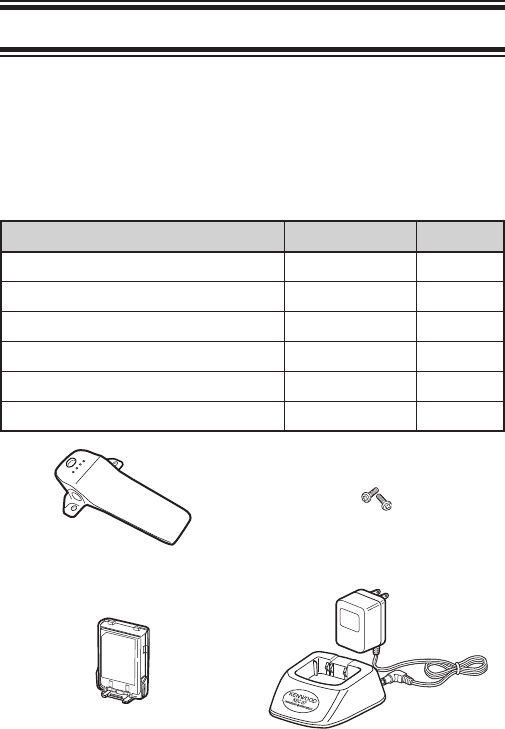
1
UNPACKING AND CHECKING EQUIPMENT
Carefully unpack the transceiver. We recommend you identify
the items listed in the following table before discarding the
packing material. If any items are missing or have been
damaged during shipment, le a claim with the carrier
immediately.
Supplied AcceSSorieS
Item Part Number Quantity
Belt clip J29-0736-XX 1
Screw set N99-2063-XX 1
KNB-46L battery pack — 1
KSC-37 rapid charger — 1
Warrany card — 1
Instruction manual B62-1976-XX 1
Belt clip Screw set
KNB-46L battery pack KSC-37 rapid charger
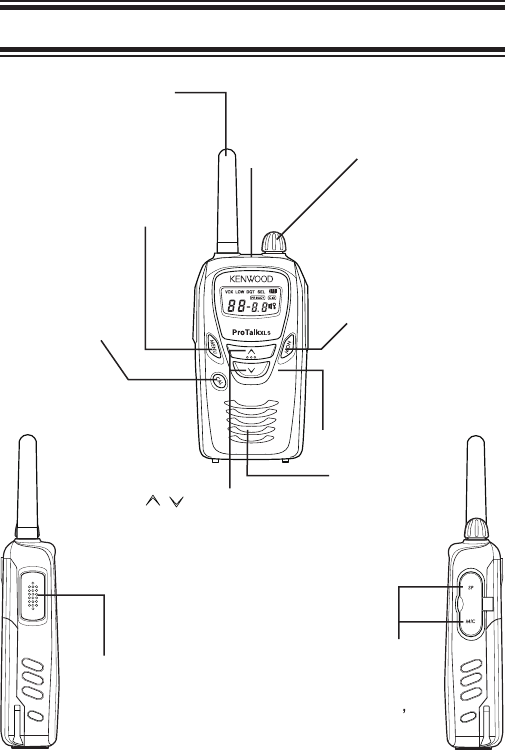
2
ORIENTATION
/ keys
Press to change the operating
channel, to select a menu in
Setting Mode, and to perform
other functions.
Antenna
Power switch/
Volume control
Turn clockwise to
switch the power
ON and counter-
clockwise to
switch the power
OFF. Rotate to
adjust the volume.
MENU key
Press to perform various
functions. Press and
hold while switching the
power ON to enter
Setting Mode.
CAL key
Press before
making a call
to alert the
other party
members, or
press to select a
unit ID to make a call
LED Indicator
Indicates the
transceiver
status.
MON key
Press to monitor
the current channel
for activity.
Microphone
Speaker
PTT (Push to Talk) switch
Press and hold, then speak
into the microphone to
transmit.
SP/MIC jacks
Lift the covers
and insert the
accessory s
plugs here.
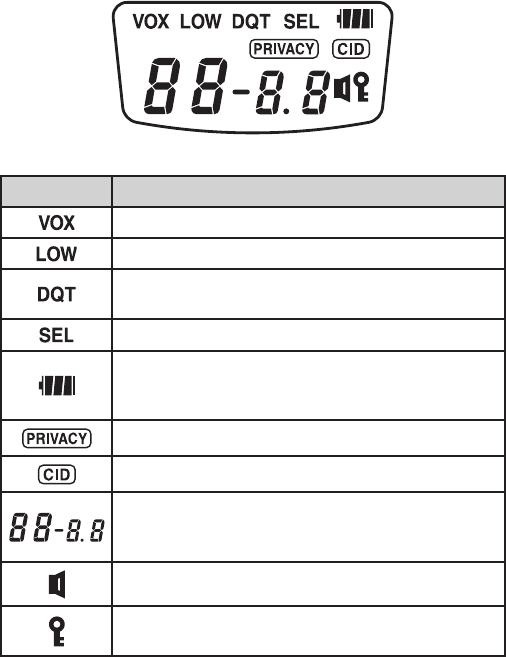
3
diSplAy
Icon Description
Appears when VOX is activated.
Appears when using low transmission power.
Appears when the channel is set up with a
DQT code.
Appears when making or receiving a selcall.
Displays the approximate battery power
remaining. Blinks when the battery power is
low.
Appears when Privacy Talk is activated.
Appears when the Caller’s ID is displayed.
Displays the channel number along with its
QT/DQT setting (if any). Also displays various
menus and menu settings.
Appears while monitoring a channel.
Appears when the transceiver keys have been
locked.
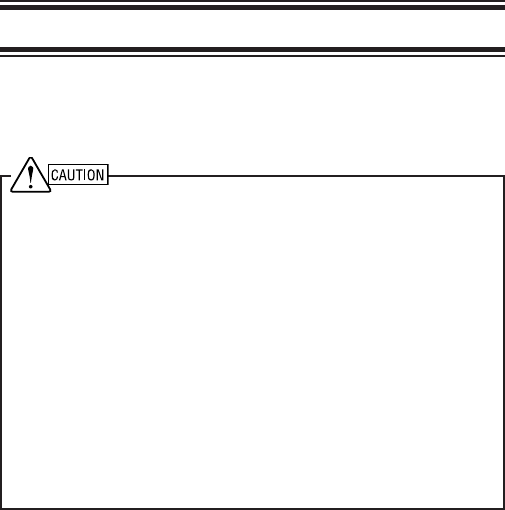
4
PREPARATION
BAttery pAck precAutionS
Do not use battery packs or battery chargers not recommended
by Kenwood.
◆ Do not recharge the battery pack if it is already fully charged.
Doing so may cause the life of the battery pack to shorten or the
battery pack may be damaged.
◆ After charging the battery pack, disconnect it from the charger.
If the charger power is reset (turned ON after being turned
OFF), recharging will start again and the battery pack will
become overcharged.
◆ Do not use the transceiver while charging the battery pack.
We recommend you switch the transceiver power OFF while
charging is taking place.
◆ Do not charge the battery pack when the battery pack or
transceiver is wet, to avoid the risk of re or damage. Wipe
the water from the battery pack or transceiver using a dry cloth
before charging.
◆ Do not short the battery terminals or dispose of the battery by
re.
◆ Never attempt to remove the casing from the battery pack.

5
Information concerning the Li-ion battery pack:
The battery pack includes ammable objects such as organic solvent.
Mishandling may cause the battery to rupture producing ames or
extreme heat, deteriorate, or cause other forms of damage to the
battery. Please observe the following prohibitive matters.
• Do not disassemble or reconstruct battery!
The battery pack has a safety function and protection circuit to
avoid danger. If they suffer serious damage, the battery may
generate heat or smoke, rupture, or burst into ame.
• Do not short-circuit the battery!
Do not join the + and – terminals using any form of metal (such
as a paper clip or wire). Do not carry or store the battery pack
in containers holding metal objects (such as wires, chain-
necklaces or hairpins). If the battery pack is short-circuited,
excessive current will ow and the battery may generate heat
or smoke, rupture, or burst into ame. It will also cause metal
objects to heat up.
• Do not incinerate or apply heat to the battery!
If the insulator is melted, the gas release vent or safety function
is damaged, or the electrolyte is ignited, the battery may
generate heat or smoke, rupture, or burst into ame.
• Do not use or leave the battery near fires, stoves, or other
heat generators (areas reaching over 80°C/ 176°F)!
If the polymer separator is melted due to high temperature,
an internal short-circuit may occur in the individual cells and
the battery may generate heat or smoke, rupture, or burst into
ame.
• Avoid immersing the battery in water or getting it wet by
other means!
If the battery becomes wet, wipe it off with a dry towel before
use. If the battery’s protection circuit is damaged, the battery
may charge at extreme current (or voltage) and an abnormal
chemical reaction may occur. The battery may generate heat or
smoke, rupture, or burst into ame.
DANGER

6
• Do not charge the battery near fires or under direct
sunlight!
If the battery’s protection circuit is damaged, the battery may
charge at extreme current (or voltage) and an abnormal
chemical reaction may occur. The battery may generate heat or
smoke, rupture, or burst into ame.
• Use only the specified charger and observe charging
requirements!
If the battery is charged in unspecied conditions (under high
temperature over the regulated value, excessive high voltage
or current over regulated value, or with a remodelled charger),
it may overcharge or an abnormal chemical reaction may occur.
The battery may generate heat or smoke, rupture, or burst into
ame.
• Do not pierce the battery with any object, strike it with an
instrument, or step on it!
This may break or deform the battery, causing a short-circuit.
The battery may generate heat or smoke, rupture, or burst into
ame.
• Do not jar or throw the battery!
An impact may cause the battery to leak, generate heat
or smoke, rupture, and/or burst into ame. If the battery’s
protection circuit is damaged, the battery may charge at an
abnormal current (or voltage), and an abnormal chemical
reaction may occur.
• Do not use the battery pack if it is damaged in any way!
The battery may generate heat or smoke, rupture, or burst into
ame.
• Do not solder directly onto the battery!
If the insulator is melted or the gas release vent or safety
function is damaged, the battery may generate heat or smoke,
rupture, or burst into ame.
• Do not reverse the battery polarity (and terminals)!
When charging a reversed battery, an abnormal chemical
reaction may occur. In some cases, an unexpected large
amount of current may ow upon discharging. The battery may
generate heat or smoke, rupture, or burst into ame.
DANGER

7
• Do not reverse-charge or reverse-connect the battery!
The battery pack has positive and negative poles. If the battery
pack does not smoothly connect with a charger or operating
equipment, do not force it; check the polarity of the battery. If
the battery pack is reverse-connected to the charger, it will be
reverse-charged and an abnormal chemical reaction may occur.
The battery may generate heat or smoke, rupture, or burst into
ame.
• Do not touch a ruptured and leaking battery!
If the electrolyte liquid from the battery gets into your eyes,
wash your eyes out with fresh water as soon as possible,
without rubbing your eyes. Go to the hospital immediately. If
left untreated, it may cause eye-problems.
• Do not charge the battery for longer than the specified
time!
If the battery pack has not nished charging even after the
regulated time has passed, stop it. The battery may generate
heat or smoke, rupture, or burst into ame.
• Do not place the battery pack into a microwave or high
pressure container!
The battery may generate heat or smoke, rupture, or burst into
ame.
• Keep ruptured and leaking battery packs away from fire!
If the battery pack is leaking (or the battery emits a bad odor),
immediately remove it from ammable areas. Electrolyte
leaking from battery can easily catch on re and may cause the
battery to generate smoke or burst into ame.
• Do not use an abnormal battery!
If the battery pack emits a bad odor, appears to have different
coloring, is deformed, or seems abnormal for any other reason,
remove it from the charger or operating equipment and do not
use it. The battery may generate heat or smoke, rupture, or
burst into ame.
DANGER
DANGER
8
■ Using the Li-ion Battery Pack
• Charge the battery pack before using it.
• To keep the battery discharge at a minimum, remove the
battery pack from the equipment when it is not in use. Store
the battery pack in a cool and dry location.
• When storing the battery pack for a long period:
1 Remove the battery pack from the equipment.
2 Discharge the battery pack, if possible.
3 Store the battery pack in a cool (below 25°C/ 77°F) and dry
location.
■ Characteristics of the Li-ion Battery Pack
• As the battery pack is charged and discharged repeatedly, the
battery capacity decreases.
• Even if the battery pack is unused, the battery pack degrades.
• It takes a longer time to charge the battery pack in cooler
areas.
• The life of battery pack is shortened when it is charged and
discharged in hotter areas. When the battery pack is stored in
a hot location, the battery pack degrades quicker. Do not leave
the battery pack in vehicles or near heating appliances.
• When the battery pack operating time becomes short, even
if it is fully charged, replace the battery pack. Continuing to
charge and discharge the battery pack may result in electrolyte
leakage.
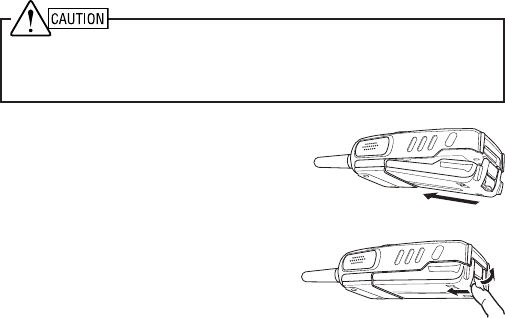
9
inStAlling/ removing the BAttery pAck
The battery pack is not charged at the factory; charge it before
use {page 10}.
Average battery pack life using low power: 12 hours
Average battery pack life using high power: 10 hours
• Average times are calculated using 5% transmit time, 5% receive
time, and 90% standby time.
◆ Do not short the battery terminals or dispose of the battery by
re.
◆ Never attempt to remove the casing from the battery pack.
1 Match the guides of the battery
pack with the corresponding
grooves on the upper rear of the
transceiver, then rmly press the
battery pack to lock it in place.
2 To remove the battery pack,
lift the safety catch, press the
release latch, then pull the
battery pack away from the
transceiver.

10
chArging the BAttery pAck
Initially charging the battery pack after purchase or extended
storage (greater than 2 months) will not bring the battery pack
to its normal operating capacity. After repeating the charge/
discharge cycle two or three times, the operating capacity will
increase to normal.
◆ Do not recharge the battery pack if it is already fully charged.
Doing so may cause the life of the battery pack to shorten or the
battery pack may be damaged.
◆ After recharging the battery pack, disconnect it from the
charger. Charging the battery pack for more than 5 days may
reduce the battery pack life due to overcharging.
Note:
◆ The ambient temperature should be between 41°F and 104°F
(5°C and 40°C) while charging is in progress. Charging outside
this range may not fully charge the battery.
◆ Always switch OFF the transceiver equipped with a battery
pack before charging. Using the transceiver while charging its
battery pack will interfere with correct charging.
◆ The battery pack life is over when its operating time decreases
even though it is fully and correctly charged. Replace the
battery pack.
1 Plug the AC adapter cable into
the adapter jack located on the
rear of the charger.
2 Plug the AC adapter into an AC
outlet.

11
3 Slide a battery pack or a
transceiver equipped with a
battery pack into the battery
pack slot.
• Make sure the metal contacts of
the battery pack mate securely
with the charger terminals.
• The indicator lights red and
charging starts.
4 When charging is completed,
the indicator lights green.
Remove the battery pack or
the transceiver from the battery
pack slot.
• It takes approximately 2.5 hours
to charge the battery pack.
• When the charger will not be
used for a long time, unplug the
AC adapter from the AC outlet.
Charger
terminals
Indicator
inStAlling/ removing the Belt clip
If desired, attach the belt clip to the
rear of the transceiver using the 2
supplied screws.

12
inStAlling/ removing optionAl AcceSSorieS
Note: Always switch OFF the transceiver power when installing or
removing optional accessories.
The following accessories can be used with this transceiver:
• KMC-17 Speaker-Microphone
• KMC-21 Speaker-Microphone
• KHS-22 Headset
• KHS-28F Headset
• EMC-3 Clip Microphone with Earphone
• EMC-6 Clip Microphone with Earphone
To install these accessories:
1 Open the SP/MIC tabs on the side of the transceiver.
2 Insert the accessory’s plugs into the SP/MIC jacks.
3 When you remove the accessory from the transceiver, be
sure to cover the SP/MIC jacks with the attached tabs, in
order to keep dust and dirt away from the contacts.
Note: Refer to the accessory instruction manuals for detailed
instructions on each of these accessories.

13
GETTING STARTED
qSwitch the Power ON.
Switch the transceiver power ON by turning
the Power switch/ Volume control clockwise.
• A conrmation tone sounds, the LCD lights up
momentarily, then the current channel number
is displayed.
To switch the transceiver power OFF, turn
the Power switch/ Volume control fully
counterclockwise, until a click sounds.
w Adjust the Volume.
Set your desired volume level by rotating the
Power switch/ Volume control.
• Clockwise increases the volume and
counterclockwise decreases the volume.
Note: To adjust the volume using background noise
as a reference, use the Monitor function {page 19}.
eSelect a Channel.
Select a channel by pressing the or
keys.
• A conrmation tone sounds each time you
press the or key.

14
• When you receive a call on your selected
channel, you will hear audio from the speaker
and the LED will light green.
• To use a signalling code, refer to “QUIET TALK/
DIGITAL QUIET TALK” on page 16.
r Make a Call.
1 Press the MON key to make sure the
channel is not in use {page 19}.
2 Press and release the CAL key to alert the
other parties that you are beginning a call.
• A calling alert tone will sound on the other
party’s transceiver.
3 Press and hold the PTT switch, then
speak into the microphone to transmit.
• The LED lights red while transmitting.
• For best sound quality, speak into the
microphone in your normal speaking
voice while holding the microphone
approximately 1.5 inches (3 to 4 cm) from
your lips.
4 Release the PTT switch when you have
nished speaking.

15
CHANNEL FREQUENCY SETUP
You can change the default frequency of each channel:
1 With the transceiver power OFF, press and hold the
MENU key (for approximately 1 second) while turning the
transceiver ON.
2 Press the or key to select a channel.
• The current frequency list number appears beside the channel
number.
3 Press the MENU key then press or to select the
frequency list number for the channel.
• Refer to page 49 for the frequencies available for each
channel.
4 Press the MENU key to conrm the selection, then repeat
steps 3 and 4 to set additional channels.
5 Press the PTT, MON, or CAL key to exit Setting Mode.
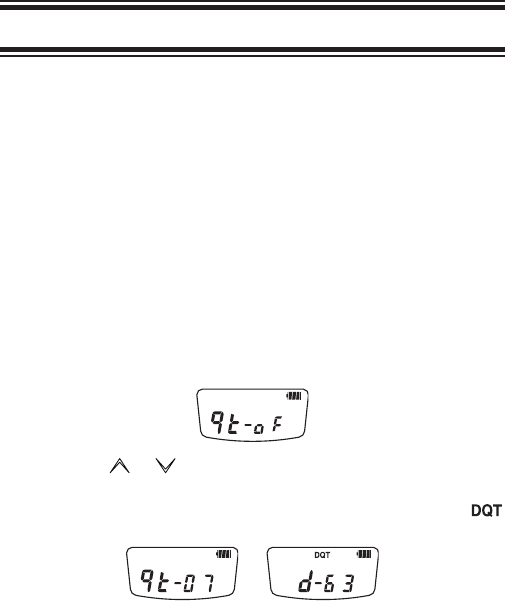
16
QUIET TALK/ DIGITAL QUIET TALK
QT (Quiet Talk) and DQT (Digital Quiet Talk) are functions
that reject signals from undesired parties that are using the
same channel as you. You will hear audio from the speaker
only when you receive a signal that contains a tone or code
matching the one set up on the channel you are using.
Likewise, when you transmit on a channel set up with QT or
DQT, the receiving station must have a matching tone or code
in order to hear your signal.
You can select a tone or code for each channel. There are
39 QT tones and 83 DQT codes. After changing the QT/ DQT
setting, conrm that the other members in your group have
selected the same tone or code.
1 Press the MENU key.
• The current setting blinks.
2 Press the or key to select your desired value.
• The values range from 01 to 39 for QT tones, then proceed to
01 to 83 for DQT codes. When selecting a DQT code, the
icon appears on the display.
• Select “oF” to turn off both QT and DQT.
• Refer to pages 47 and 48 for the tones/codes corresponding to
the QT/DQT numbers.
3 Press the MENU key 4 times, or press the PTT, MON, or
CAL key to conrm the selection and return to operating
mode.

17
SCANNING THE CHANNELS
You can scan the transceiver channels to search for a signal.
When the transceiver veries a signal on a channel, it proceeds
to check whether or not its QT/ DQT setting matches that
which is set up on your transceiver (if you have set a channel
with QT/ DQT). If the QT/ DQT matches, the transceiver stops
at the channel and opens the squelch so you can listen to the
call. If the QT/ DQT does not match, the call is ignored and
scanning continues.
Before you can use the scan function, ensure that it is
activated. You can turn the scan function (the ability to perform
scan) ON or OFF in Setting mode.
1 With the transceiver power OFF, press and hold the MENU
key while turning the transceiver power ON (for 1 second).
2 Press the or key to select “SC”.
3 Press the MENU key then press or to select “SC-oF”
(scan function disabled) or “SC-on” (scan function enabled).
• If you select “SC-oF”, you will no longer be able to perform
scan by pressing and holding the key {page 18}.
4 Press the MENU key to conrm the selection.
5 Press the PTT, MON, or CAL key to exit Setting Mode.
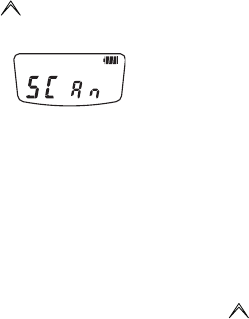
18
To begin scanning:
1 Press and hold the key for 1 second.
• “SCAn” appears on the display.
2 When a signal is detected and the QT/ DQT matches, the
channel number appears on the display and blinks.
3 When the signal is no longer present, the transceiver waits
for 5 seconds before scanning continues.
• If a new signal appears before the 5 seconds elapse, the
transceiver will remain on the channel until the new signal is
no longer present, at which time it will again wait for 5 seconds
before continuing.
4 To end the scan at any time, press and hold the key for
1 second.
• The transceiver returns to the channel you were using before
you started scanning.
revert chAnnel
The revert channel is the channel from which you start
scanning. So, for example, if you are on channel 1 when you
begin to scan, your revert channel is channel 1.
During scan, pressing the PTT switch will automatically
select the transceiver’s revert channel (in the above example,
channel 1) and you will begin transmitting. However, if you are
currently paused on another channel after having received a
signal (for example, channel 2), pressing the PTT switch will
allow you to transmit on that channel, rather than returning
to the revert channel. Scanning will resume after 5 seconds,
unless a signal is present on the channel.

19
MONITORING A CHANNEL
When no signals are present, the squelch on the transceiver
automatically mutes the speaker so you will not hear
background noise. Using the MON key, you can open the
squelch to unmute the speaker. This allows you to:
• conrm the channel activity so you don’t make a call while another
party is using the same channel
• adjust the volume level without having to wait for a call
• listen to an intermittent call (due to a weak signal) without it
continuously cutting out
To manually open the squelch, press and hold the MON key.
• When squelch is open, the icon appears on the display and the
LED lights green.
To return to normal operation, release the MON key.
Squelch level
You can adjust the default squelch level of the transceiver.
1 With the transceiver power OFF, press and hold the MENU
key while turning the transceiver power ON (for 1 second).
2 Press the or key to select “Sq”.
3 Press the MENU key then press or to select “Sq- 0”
(open), “Sq- 1” (default setting), or “Sq- 2” (tight).
4 Press the MENU key to conrm the selection.
5 Press the PTT, MON, or CAL key to exit Setting Mode.

20
VOICE ACTIVATED CONTROL (VOX)
Using the VOX feature, you can operate the transceiver
hands-free. In order to use this feature, however, you must
use an optional headset; VOX will not function with the built-in
microphone. For best operation conditions, we recommend
you use an optional headset with both an ear piece and a
microphone on a boom that rests in front of your mouth.
voX operAtion
1 Set up a VOX gain level from 1 to 5 {below}.
2 To transmit, speak into the headset microphone.
• You do not need to press the PTT switch; the transceiver
automatically detects your voice and begins transmitting.
3 To stop transmitting, stop speaking.
• Transmission will continue momentarily after you stop
speaking. You can select the delay time as described above.
4 To exit VOX mode, set the VOX gain level {below} to
“GL-oF” (VOX function off).
voX gAin
With VOX activated, your voice level will determine when you
transmit. Due to the automatic switching between transmission
and reception, we recommend you set the VOX gain such that it
will not activate when in an area with excessive ambient noise.
1 With the transceiver power OFF, press and hold the MENU
key while turning the transceiver power ON (for 1 second).
2 Press the or key to select “GL”.
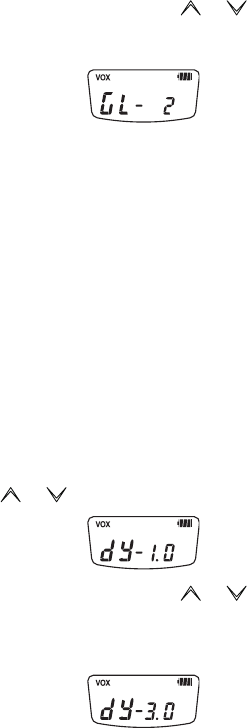
21
3 Press the MENU key then press or to select “GL-oF”
(VOX function off) or “GL- 1” (VOX gain level 1) to “GL- 5”
(VOX gain level 5).
• While adjusting the VOX Gain, speak into the microphone.
When an appropriate level is reached, the LED lights orange.
• Setting the VOX gain to OFF deactivates VOX. In order to
transmit with VOX turned off, you must use the PTT switch.
4 Press the MENU key to conrm the selection.
5 Press the PTT, MON, or CAL key to exit Setting Mode.
voX delAy time
If the transceiver returns to receive mode too quickly after
you stop speaking, the end of your message may not be
transmitted. To avoid this, select an appropriate delay time that
allows your entire message to be transmitted. However, do not
make the delay overly long.
1 With the transceiver power OFF, press and hold the MENU
key while turning the transceiver power ON (for 1 second).
2 Press the or key to select “dY”.
3 Press the MENU key then press or to select “dY-0.1”
(0.1 seconds), “dY-0.3” (0.3 seconds), “dY-0.5”
(0.5 seconds), “dY-1.0” (1 second), “dY-1.5” (1.5 seconds),
or “dY-3.0” (3 seconds).

22
• While adjusting the VOX Delay Time, speak into the
microphone to simulate transmitting. The LED lights orange
while speaking, but no signal is transmitted at this time.
4 Press the MENU key to conrm the selection.
5 Press the PTT, MON, or CAL key to exit Setting Mode.
voX trAnSmit inhiBit
While using VOX, you can set the transceiver to detect when
the channel is in use (in place of using the Monitor function).
With this function turned on, VOX will not allow you to transmit
while the channel is being used. You can transmit only when
the channel is free. Setting up the proceed tone function
{page 23} will notify you when the channel is free.
1 With the transceiver power OFF, press and hold the MENU
key while turning the transceiver power ON (for 1 second).
2 Press the or key to select “tI”.
3 Press the MENU key then press or to select “tI-on”
(transmit inhibit on) or “tI-oF” (transmit inhibit off).
4 Press the MENU key to conrm the selection.
5 Press the PTT, MON, or CAL key to exit Setting Mode.

23
voX proceed tone
You can set the transceiver to sound an alert tone when you
are able to transmit (transmission is no longer inhibited).
1 With the transceiver power OFF, press and hold the MENU
key while turning the transceiver power ON (for 1 second).
2 Press the or key to select “Pd”.
3 Press the MENU key then press or to select “Pd-on”
(VOX proceed tone on) or “Pd-oF” (VOX proceed tone off).
• You can speak into the microphone at this time to simulate
transmitting. The LED lights orange while speaking if your
voice is at an appropriate level, but no signal is transmitted at
this time.
4 Press the MENU key to conrm the selection.
5 Press the PTT, MON, or CAL key to exit Setting Mode.

24
PRIVACY TALK
Whereas the Quiet Talk and Digital Quiet Talk functions
{page 16} allow you to ignore unwanted calls, Privacy Talk
allows you to hold a conversation in complete privacy. When
activated, the transceiver scrambles your voice so that
anybody listening to your conversation will not be able to
understand what you are saying.
In order for members of your own group to understand your
call while you are using Privacy Talk, all other members must
also activate Privacy Talk on their transceivers. This scrambles
everybody’s voice while transmitting and descrambles the
voice message on your own transceiver when you receive the
message.
1 Press the MENU key 2 times.
• The icon appears on the display and blinks.
2 Press the or key to select “on” (privacy on) or “oF”
(privacy off).
3 Press the MENU key 3 times, or press the PTT, MON, or
CAL key to conrm the selection and return to operating
mode.
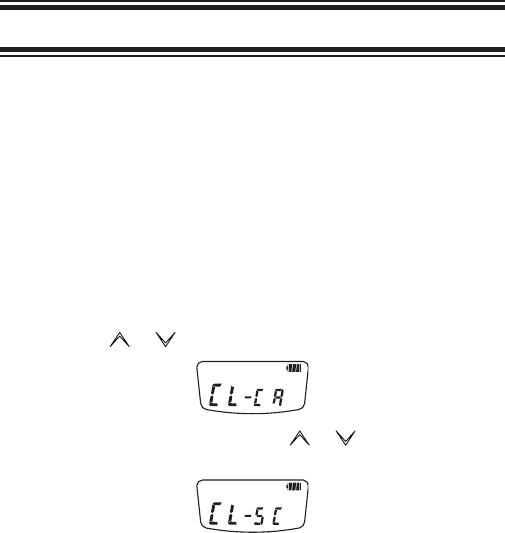
25
CALL KEY SETUP
You can set up the transceiver CAL key to perform 1 of 2
functions, or you can turn the CAL key off (unused):
Calling Alert: Press the CAL key before making a call will
send your calling alert tone to your party members, identifying
yourself before speaking.
Selcall: Press the CAL key then select from a list of IDs to
make calls to specic transceivers.
To set up the CAL key:
1 With the transceiver power OFF, press and hold the MENU
key while turning the transceiver power ON (for 1 second).
2 Press the or key to select “CL”.
3 Press the MENU key then press or to select “CL-CA”
(calling alert), “CL-SC” (selcall), or “CL-oF” (off).
4 Press the MENU key to conrm the selection.
5 Press the PTT, MON, or CAL key to exit Setting Mode.

26
cAlling Alert
Calling alert tones are used to identify yourself to your party
members. You can set up a calling alert tone to one of 10
types. If each party member uses a different calling alert tone,
it is easy to know who is making the call. Pressing the CAL
key before making a call will send your calling alert tone to your
party members.
To set up your own calling alert tone:
1 With the transceiver power OFF, press and hold the MENU
key while turning the transceiver power ON (for 1 second).
2 Press the or key to select “CA”.
3 Press the MENU key then press or to select “CA-oF"
(calling alert off) or “CA- 1” (calling alert tone 1) to “CA-10”
(calling alert tone 10).
• Each time you press or to select a calling alert tone, the
new tone sounds.
4 Press the MENU key to conrm the selection.
5 Press the PTT, MON, or CAL key to exit Setting Mode.
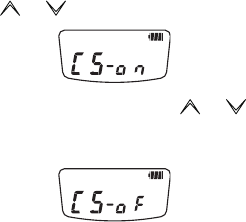
27
■ cAlling Alert Side tone
When the CAL key is pressed, the calling alert tone will
sound through your own speaker as well.
To turn the Calling Alert Side Tone on or off, on your own
transceiver:
1 With the transceiver power OFF, press and hold the
MENU key while turning the transceiver power ON (for
1 second).
2 Press the or key to select “CS”.
3 Press the MENU key then press or to select
“CS-on” (Calling Alert Side Tone is on) or “CS-oF”
(Calling Alert Side Tone is off).
4 Press the MENU key to conrm the selection.
5 Press the PTT, MON, or CAL key to exit Setting Mode.

28
SelcAll (Selective cAlling)
A Selcall is a voice call to a particular station or group of
stations. Each transceiver is set up with an individual ID
number for use with selcalls.
■ mAking A SelcAll
1 Press the CAL key.
2 Press the or key to select an ID number.
• “Id” represents a single station, “GP” represents a group of
stations, and “AL” represents all stations.
3 Press the PTT switch to transmit the selected selcall ID.
• The transceiver waits for the Data Transmit Modulation
Delay time {page 29} before transmitting the selcall ID.
• The side tone sounds if PTT ID side tone {page 30} is
enabled.
4 Release the PTT switch, then continue the call as
normal when you receive a response.
5 Press the CAL key to end the call.
Note: If Optional Signalling (menu “oP”) has been set to “FS”
(FleetSync), you can also set up an Individual Selcall Alert
type (menu “IA”) and Group Selcall Alert type (menu “GA”).
Individual and Group Selcall Alert types range from “-oF” (off)
and “- 1” (type 1) to “-10” (type 10). Refer to the menu list on
page 45.
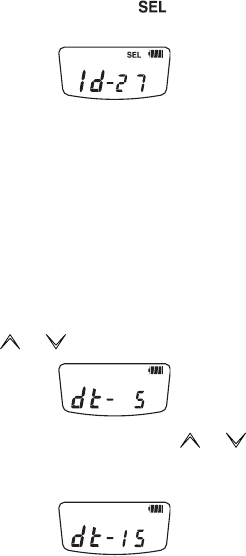
29
■ receiving A SelcAll
When a selcall is received, the icon appears on the
display along with the ID of the caller.
Press the PTT switch and speak into the microphone to
respond to the call, then continue the call as normal. When
the call is nished, press the CAL key to end the call.
■ dAtA trAnSmit modulAtion delAy time
To set up a data transmit modulation delay time:
1 With the transceiver power OFF, press and hold the
MENU key while turning the transceiver power ON (for
1 second).
2 Press the or key to select “dt”.
3 Press the MENU key then press or to select
“dt- 0” (0 ms), “dt- 5” (500 ms), “dt-10” (1000 ms),
“dt-15” (1500 ms), or “dt-20” (2000 ms).
4 Press the MENU key to conrm the selection.
5 Press the PTT, MON, or CAL key to exit Setting Mode.
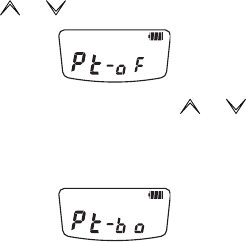
30
■ ptt id
The transceiver can send a PTT ID signal when pressing
the PTT switch (beginning of transmission) or when
pressing and releasing (beginning of transmission and end
of transmission) the PTT switch.
1 With the transceiver power OFF, press and hold the
MENU key while turning the transceiver power ON (for
1 second).
2 Press the or key to select “Pt”.
3 Press the MENU key then press or to select
“Pt-oF” (PTT ID is off), “Pt-bo” (send your own PTT ID at
the beginning of transmission), or “Pt-LI” (send the list
PTT ID at the beginning and end of transmission).
4 Press the MENU key to conrm the selection.
5 Press the PTT, MON, or CAL key to exit Setting Mode.
■ ptt id Side tone
When the PTT switch is pressed and/or released, a tone
will sound through your own speaker when the PTT ID is
transmitted.
To turn the PTT ID Side Tone on or off:
1 With the transceiver power OFF, press and hold the
MENU key while turning the transceiver power ON (for
1 second).

31
2 Press the or key to select “St”.
3 Press the MENU key then press or to select
“St-on” (PTT ID Side Tone is on) or “St-oF” (PTT ID Side
Tone is off).
4 Press the MENU key to conrm the selection.
5 Press the PTT, MON, or CAL key to exit Setting Mode.
■ mute hold time
Mute Hold Time keeps the speaker muted for a brief
moment, after a signal has been received. This prevents
interference with the PTT ID signal.
To set the hold time:
1 With the transceiver power OFF, press and hold the
MENU key while turning the transceiver power ON (for
1 second).
2 Press the or key to select “Hd”.
3 Press the MENU key then press or to select
“Hd-oF” (hold time is off), “Hd- 5” (500 ms), “Hd-10”
(1000 ms), “Hd-15” (1500 ms), “Hd-20” (2000 ms), or
“Hd-25” (2500 ms).
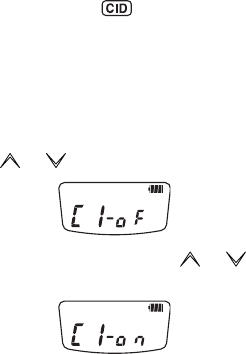
32
4 Press the MENU key to conrm the selection.
5 Press the PTT, MON, or CAL key to exit Setting Mode.
■ cAller id
If set up by your dealer, when the transceiver receives
a PTT ID signal, the caller ID of that signal appears on
the display, along with the icon, so you know who is
making the call.
To turn Caller ID on or off:
1 With the transceiver power OFF, press and hold the
MENU key while turning the transceiver power ON (for
1 second).
2 Press the or key to select “CI”.
3 Press the MENU key then press or to select
“CI-on” (Caller ID is on) or “CI-oF” (Caller ID is off).
4 Press the MENU key to conrm the selection.
5 Press the PTT, MON, or CAL key to exit Setting Mode.

33
OPERATING FEATURES
SpeAker mute
If Speaker Mute is activated by your dealer, no sound will be
emitted from the transceiver speaker. In order to hear any
received signals, you must use a headset.
trAnSmiSSion power
You can adjust the transmission power on all channels.
Selecting low power will allow longer use of the battery pack.
Selecting high power will allow you to transmit farther, in case
the other party is too far away for low power usage.
To change the transmission power:
1 Press the MENU key 3 times.
2 Press the or key to select “Lo” (low power) or “HI”
(high power).
• The icon appears on the display when low power is
selected.
3 Press the MENU key 2 times, or press the PTT, MON, or
CAL key to conrm the selection and return to operating
mode.
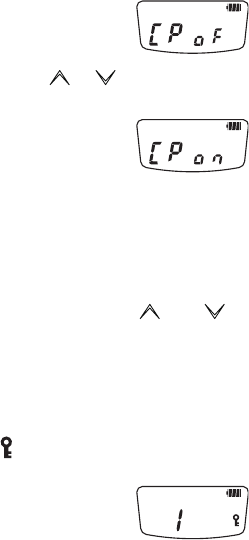
34
compAnder
The compander (compressor/expander) allows higher clarity
of signals, avoiding excessive noise and interference. When
activated, transmitted signals are compressed before being
sent and received signals are expanded when they arrive.
1 Press the MENU key 4 times.
2 Press the or key to select “CP-oF” (compander off) or
“CP-on” (compander on.
3 Press the MENU key 1 time, or press the PTT, MON, or
CAL key to conrm the selection and return to operating
mode.
key lock
You can lock the MENU, , and keys to prevent
accidentally changing the operating mode and channel
settings. The Power switch/ Volume control and PTT, CAL,
and MON still function normally.
Press and hold the MENU key for 3 seconds to lock or unlock
the transceiver keys.
• The icon appears on the display when the transceiver keys are
locked. No icon appears when they are unlocked.
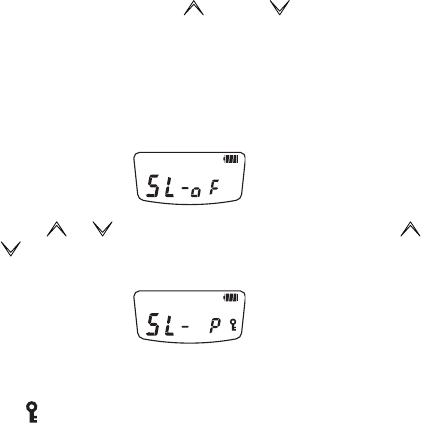
35
Super lock
You can lock the MENU, CAL, , and/or keys, and disable
the Setting Mode. PTT and MON still function normally.
To select the super lock setting:
1 With the transceiver power OFF, press and hold the PTT
switch and the CAL key while turning the transceiver power
ON (for 1 second).
2 Press the or key to select “SL- P” (MENU, CAL, ,
and keys locked), “SL- C” (MENU and CAL keys
locked), or “SL-oF” (super lock off).
3 Press the MENU, PTT, MON, or CAL key to exit Super
Lock Setting Mode.
• The icon appears on the display when the transceiver keys
are locked. No icon appears when they are unlocked.
diSplAy BAcklight
You can set the display backlight to remain off, remain on, or
turn on when you press any key other than the PTT switch
(auto). When set to auto, the backlight remains on for 5
seconds after pressing a key, before turning off again.
To select the backlight setting:
1 With the transceiver power OFF, press and hold the
MENU (for approximately 1 second) key while turning the
transceiver power ON.
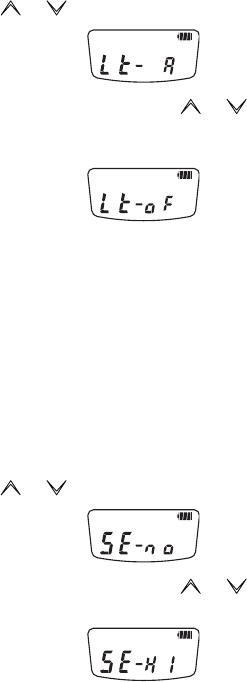
36
2 Press the or key to select “Lt”.
3 Press the MENU key then press or to select “Lt-oF”
(backlight off), “Lt-on” (backlight on), or “Lt- A” (backlight
auto).
4 Press the MENU key to conrm the selection.
5 Press the PTT, MON, or CAL key to exit Setting Mode.
microphone SenSitivity
You can adjust the sensitivity level of the transceiver
microphone.
To select the microphone sensitivity:
1 With the transceiver power OFF, press and hold the MENU
key while turning the transceiver power ON (for 1 second).
2 Press the or key to select “SE”.
3 Press the MENU key then press or to select “SE-no”
(normal) or “SE-HI” (high).
4 Press the MENU key to conrm the selection.
5 Press the PTT, MON, or CAL key to exit Setting Mode.
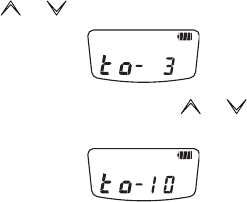
37
time-out timer
The Time-out Timer prevents you from using a channel for a
extended durations. This function is useful, for example, when
you accidentally keep the PTT switch pressed. Additionally, by
limiting the amount of time you can continuously transmit, this
feature helps you save on battery power consumption.
If you continuously transmit for 3 minutes (default value), the
transceiver will stop transmitting and a tone will sound. To
stop the tone, release the PTT switch. You can press the PTT
switch again to resume transmitting.
To change the default value of 3 minutes:
1 With the transceiver power OFF, press and hold the MENU
key while turning the transceiver power ON (for 1 second).
2 Press the or key to select “to”.
3 Press the MENU key then press or to select “to- 3”
(3 minutes) or “to-10” (10 minutes).
4 Press the MENU key to conrm the selection.
5 Press the PTT, MON, or CAL key to exit Setting Mode.
This transceiver is also equipped with a pre-alert tone which
sounds 10 seconds before the Time-out Timer expires.
This will allow you time to nish your message before the
transceiver automatically stops transmitting.
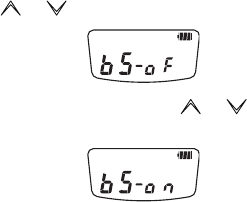
38
BAttery SAve
This transceiver has been designed to give you the most out of
your battery power. The battery save function decreases the
amount of power used when a signal is not being received and
no operations are being performed.
While using the transceiver, battery save will automatically
switch ON after 5 seconds have elapsed with no operations or
received calls. Operating the transceiver or receiving a call will
switch this feature OFF until 5 seconds of non-operation occurs
again.
To turn this function on or off:
1 With the transceiver power OFF, press and hold the MENU
key while turning the transceiver power ON (for 1 second).
2 Press the or key to select “bS”.
3 Press the MENU key then press or to select “bS-on”
(battery save on) or “bS-oF” (battery save off).
4 Press the MENU key to conrm the selection.
5 Press the PTT, MON, or CAL key to exit Setting Mode.
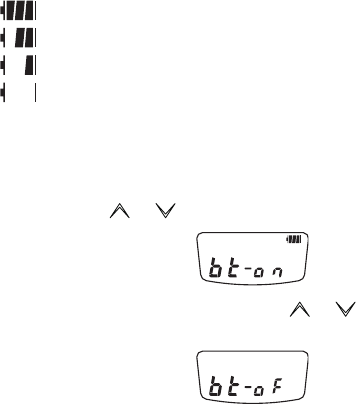
39
BAttery indicAtor
When turned ON, the battery indicator on the display lets you
know approximately how much battery life is remaining. When
turned OFF, the battery indicator will appear and blink only
when the battery voltage level is low.
When the battery voltage becomes too low while transmitting,
the transceiver stops transmitting, a tone sounds, and the
LED blinks red until you release the PTT switch. Recharge or
replace the battery pack at this time.
High battery power
Medium battery power
Low battery power
Recharge the battery pack
To turn this function on or off:
1 With the transceiver power OFF, press and hold the MENU
key while turning the transceiver power ON (for 1 second).
2 Press the or key to select “bt”.
3 Press the MENU key then press or to select “bt-on”
(battery indicator on) or “bt-oF” (battery indicator off).
4 Press the MENU key to conrm the selection.
5 Press the PTT, MON, or CAL key to exit Setting Mode.
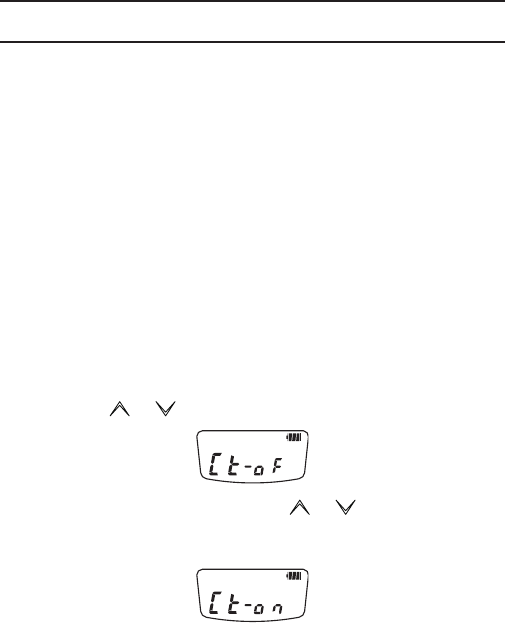
40
incoming cAll notificAtion type
Note: To use Incoming Call Notication, you must set up a QT tone
or a DQT code {page 16}.
Incoming Call Notication is used to inform you of when a call
is being received. When activated, a tone is emitted when a
busy signal is received and the QT/ DQT signalling matches.
• The tone will sound for 15 seconds before turning off.
• While the tone sounds, you will not hear any audio from the
speaker. Press any key to turn the tone off and listen to the
received call.
After the call is nished, the transceiver will wait for 10 seconds
before resetting. If you receive a new call within those 10
seconds, the tone will not sound. If no call is received within
10 seconds, Incoming Call Notication will reset so that the
next time a call is received, the tone will sound again.
To turn Incoming Call Notication on or off:
1 With the transceiver power OFF, press and hold the MENU
key while turning the transceiver power ON (for 1 second).
2 Press the or key to select “Ct”.
3 Press the MENU key then press or to select “Ct-oF”
(incoming call notication off), or “Ct-on” (incoming call
notication on).
4 Press the MENU key to conrm the selection.
5 Press the PTT, MON, or CAL key to exit Setting Mode.
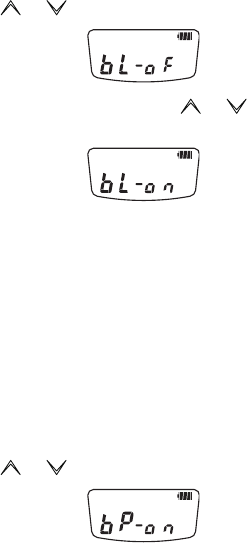
41
BuSy chAnnel lockout (Bcl)
This function is used in order to prevent transmitting on a
channel that somebody else is currently using. When turned
ON, a beep sounds when you press the PTT switch while
another party is using the channel, and you cannot transmit.
To turn BCL on or off:
1 With the transceiver power OFF, press and hold the MENU
key while turning the transceiver power ON (for 1 second).
2 Press the or key to select “bL”.
3 Press the MENU key then press or to select “bL-on”
(BCL on) or “bL-oF” (BCL off).
4 Press the MENU key to conrm the selection.
5 Press the PTT, MON, or CAL key to exit Setting Mode.
trAnSceiver Beep
When you turn the transceiver power ON or press a key, a
beep will emit from the transceiver.
To turn the transceiver beep on or off:
1 With the transceiver power OFF, press and hold the MENU
key while turning the transceiver power ON (for 1 second).
2 Press the or key to select “bP”.
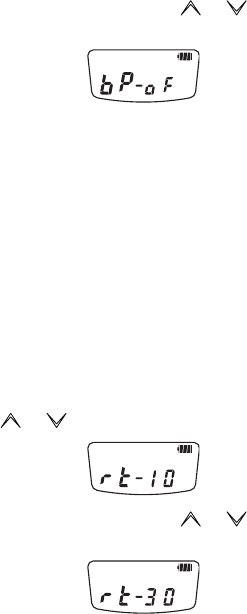
42
3 Press the MENU key then press or to select “bP-on”
(beep on) or “bP-oF” (beep off).
4 Press the MENU key to conrm the selection.
5 Press the PTT, MON, or CAL key to exit Setting Mode.
mode reSet time
This function returns the transceiver to the channel display
after a preset timer expires while in Menu mode or ID List
mode.
To set the mode reset timer:
1 With the transceiver power OFF, press and hold the MENU
key while turning the transceiver power ON (for 1 second).
2 Press the or key to select “rt”.
3 Press the MENU key then press or to select “rt-oF”
(timer off), “rt-10” (10 seconds), “rt-30” (30 seconds).
4 Press the MENU key to conrm the selection.
5 Press the PTT, MON, or CAL key to exit Setting Mode.
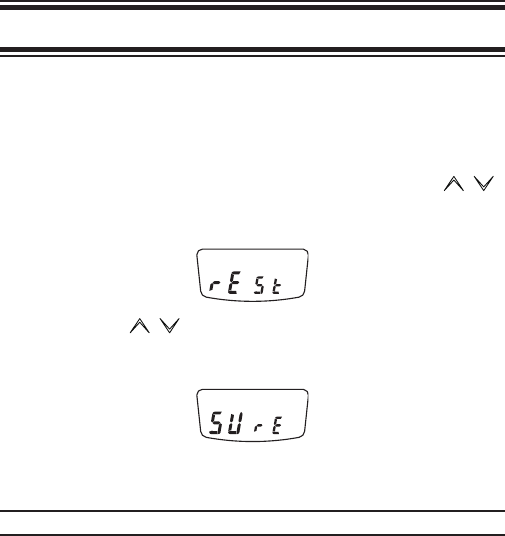
43
RESETTING THE TRANSCEIVER
At some point in time, you may desire to reset the transceiver
settings to their default values. (Default values are listed on
pages 45 ~ 46.)
To reset the transceiver:
1 With the transceiver power OFF, press and hold the , ,
and MON keys while turning the transceiver power ON.
• “rESt” (reset) will appear on the display.
2 Release the , , and MON keys.
• The conrmation message “SUrE” (sure) will appear on the
display.
3 Press the PTT switch to reset the transceiver.
• Press any other key to cancel the reset.
Note: Reset will function even if Super Lock has been activated.
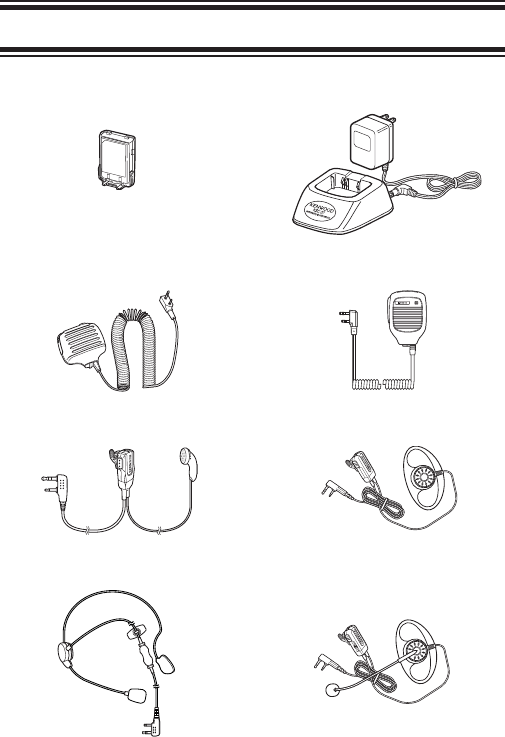
44
OPTIONAL ACCESSORIES
KNB-46L (Li-ion battery pack) KSC-37 (Rapid charger)
KMC-17 (Speaker-microphone) KMC-21 (Speaker-microphone)
EMC-3
(Clip mic with earphone)
EMC-6
(Clip mic with earphone)
KHS-22 (Headset) KHS-28F (Headset)

45
MENUS
Menu Name Settings Default Ref. Pg
Channel 1
Frequency Setting F1 ~ F56 F2 15
Channel 2
Frequency Setting F1 ~ F56 F8 15
~
1
Channels 3 ~ 16
Frequency Setting F1 ~ F56
F9 ~ F22
15
Optional Signalling OFF/ FS
(FleetSync) OFF 28
2 Individual Selcall
Alert OFF/ 1 ~ 10 1 28
2 Group Selcall Alert OFF/ 1 ~ 10 2 28
3 Incoming Call
Notication Type OFF/ ON (Tone) OFF 40
Call Key CA (Call Alert)/
SC (Selcall)/ OFF CA 25
4 Calling Alert Tone Type 1 ~ 10 1 26
Calling Alert Side
Tone ON/ OFF ON 27
PTT ID OFF/ bo (BOT)/
L1 (List 1) OFF 30
PTT ID Side Tone ON/ OFF ON 30
Data TX
Modulation Delay
Time
0/ 5 (500)/ 10
(1000)/ 15 (1500)/
20 (2000 ms)
500 ms 29
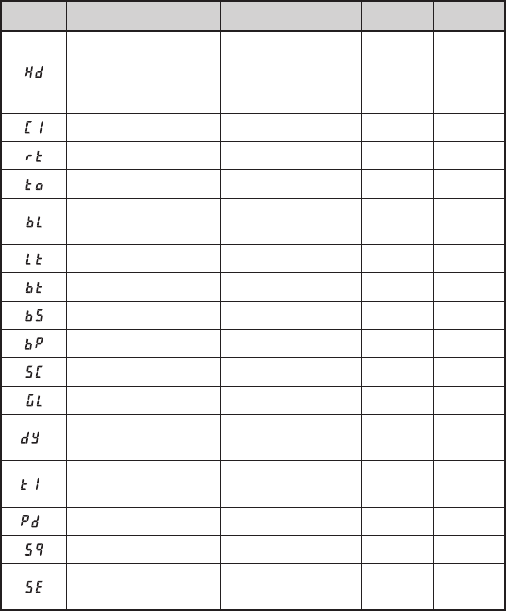
46
Menu Name Settings Default Ref. Pg
Mute Hold Time
OFF/ 5 (500)/ 10
(1000)/ 15 (1500)/
20 (2000)/ 25
(2500 ms)
OFF 31
Caller ID Display OFF/ ON OFF 32
Mode Reset Time OFF/ 10/ 30 sec 10 sec 42
Time-out Timer 3/ 10 min 3 min 37
Busy Channel
Lockout OFF/ ON OFF 41
Backlight
OFF/ ON/ A (Auto)
Auto 35
Battery Indicator OFF/ ON ON 39
Battery Save OFF/ ON OFF 38
Beep OFF/ ON ON 41
Scan Function OFF/ ON OFF 17
VOX Gain OFF/ 1 ~ 5 OFF 20
5 VOX Delay Time 0.1/ 0.3/ 0.5/ 1.0/
1.5/ 3.0 sec 1.0 sec 21
5 Transmit Inhibit
(while receiving) OFF/ ON OFF 22
5 VOX Proceed Time OFF/ ON OFF 23
Squelch Level 0 ~ 2 1 19
Mic Sensitivity no (Normal)/
HI (high) Normal 36
1 Menus 3 ~ 16 are not available on 2 channel models.
2 Menus IA and GA are not available if the oP menu is set to OFF.
3 Menu Ct is not available if oP menu is set to FleetSync.
4 Menu CA is not available if the CL menu is set to OFF or Selcall.
5 Menus dY, tI, and Pd are not available if the GL menu is set to OFF.

47
QT TONES/ DQT CODES
Display
QT Freq.
Display
QT Freq.
Display
QT Freq.
01 67.0 Hz 14 107.2 Hz 27 167.9 Hz
02 71.9 Hz 15 110.9 Hz 28 173.8 Hz
03 74.4 Hz 16 114.8 Hz 29 179.9 Hz
04 77.0 Hz 17 118.8 Hz 30 186.2 Hz
05 79.7 Hz 18 123.0 Hz 31 192.8 Hz
06 82.5 Hz 19 127.3 Hz 32 203.5 Hz
07 85.4 Hz 20 131.8 Hz 33 210.7 Hz
08 88.5 Hz 21 136.5 Hz 34 218.1 Hz
09 91.5 Hz 22 141.3 Hz 35 225.7 Hz
10 94.8 Hz 23 146.2 Hz 36 233.6 Hz
11 97.4 Hz 24 151.4 Hz 37 241.8 Hz
12 100.0 Hz 25 156.7 Hz 38 250.3 Hz
13 103.5 Hz 26 162.2 Hz 39 69.3 Hz

48
Display
DQT Code
Display
DQT Code
Display
DQT Code
DQT 01 023N DQT 29 174N DQT 57 445N
DQT 02 025N DQT 30 205N DQT 58 464N
DQT 03 026N DQT 31 223N DQT 59 465N
DQT 04 031N DQT 32 226N DQT 60 466N
DQT 05 032N DQT 33 243N DQT 61 503N
DQT 06 043N DQT 34 244N DQT 62 506N
DQT 07 047N DQT 35 245N DQT 63 516N
DQT 08 051N DQT 36 251N DQT 64 532N
DQT 09 054N DQT 37 261N DQT 65 546N
DQT 10 065N DQT 38 263N DQT 66 565N
DQT 11 071N DQT 39 265N DQT 67 606N
DQT 12 072N DQT 40 271N DQT 68 612N
DQT 13 073N DQT 41 306N DQT 69 624N
DQT 14 074N DQT 42 311N DQT 70 627N
DQT 15 114N DQT 43 315N DQT 71 631N
DQT 16 115N DQT 44 331N DQT 72 632N
DQT 17 116N DQT 45 343N DQT 73 654N
DQT 18 125N DQT 46 346N DQT 74 662N
DQT 19 131N DQT 47 351N DQT 75 664N
DQT 20 132N DQT 48 364N DQT 76 703N
DQT 21 134N DQT 49 365N DQT 77 712N
DQT 22 143N DQT 50 371N DQT 78 723N
DQT 23 152N DQT 51 411N DQT 79 731N
DQT 24 155N DQT 52 412N DQT 80 732N
DQT 25 156N DQT 53 413N DQT 81 734N
DQT 26 162N DQT 54 423N DQT 82 743N
DQT 27 165N DQT 55 431N DQT 83 754N
DQT 28 172N DQT 56 432N oF OFF

49
CHANNEL FREQUENCIES
Setup
Number
Frequency
(MHz)
Setup
Number
Frequency
(MHz)
Setup
Number
Frequency
(MHz)
01
(CH 9)
464.5000 20 461.3125 39 466.1625
02
(CH 1)
464.5500 21 461.3375 40 466.1875
03
(CH 10)
467.7625 22 461.3625 41 466.2125
04
(CH 11)
467.8125 23 462.7625 42 466.2375
05
(CH 12)
467.8500 24 462.7875 43 466.2625
06
(CH 13)
467.8750 25 462.8125 44 466.2875
07
(CH 14)
467.9000 26 462.8375 45 466.3125
08
(CH 2)
467.9250 27 462.8625 46 466.3375
09
(CH 3)
461.0375 28 462.8875 47 466.3625
10
(CH 4)
461.0625 29 462.9125 48 467.7875
11
(CH 5)
461.0875 30 464.4875 49 467.8375
12
(CH 6)
461.1125 31 464.5125 50 467.8625
13
(CH 7)
461.1375 32 464.5375 51 467.8875
14
(CH 8)
461.1625 33 464.5625 52 467.9125
15
(CH 15)
461.1875 34 466.0375 53 469.4875
16
(CH 16)
461.2125 35 466.0625 54 469.5125
17 461.2375 36 466.0875 55 469.5375
18 461.2625 37 466.1125 56 469.5625
19 461.2875 38 466.1375
Note: The marked CH numbers are the default channel settings.

50
SPECIFICATIONS
RF output power Low 500 mW
High 1.5 W
Audio output power 100 mW
Frequency stability ±2.5 ppm
Operating voltage 3.3 V ~ 5.0 V
Dimensions
(projections not included)
52 x 28.7 x 103.5 mm
(2.05 x 1.13 x 4.07 inches)
Weight (with KNB-46L) 165 g (5.8 oz)

51
TROUBLESHOOTING GUIDE
Problem Solution
Cannot turn
the transceiver
power ON.
• The battery pack may be dead.
Recharge or replace the battery pack.
• The battery pack may not be installed
correctly. Remove the battery pack
and install it again.
Battery power
dies shortly after
charging.
• The battery pack life is nished.
Replace the battery pack with a new
one.
Cannot talk to
or hear other
members in your
group.
• Make sure you are using the same
frequency and QT/DQT setting as the
other group members.
• Other group members may be
using Privacy Talk. Turn on your
transceiver’s Privacy Talk.
• Other group members may be too
far away. Make sure you are within
range of the other transceivers.
Other voices
(besides group
members) are
present on the
channel.
• Change the QT/DQT settings. Make
sure all group members change the
settings on their transceivers to match
the new QT/DQT setting.
The transceiver
is malfunctioning
for no apparent
reason.
• Reset the transceiver as described on
page 43

RADIO FREQUENCY ENERGY SAFETY INFORMATION
This KENWOOD transceiver has been evaluated and complies with the standards listed below, in
regards to Radio Frequency (RF) energy and electromagnetic energy (EME) generated by the
transceiver.
•FCC RF exposure limits for
Occupational Use Only.
RF Exposure limits adopted by the FCC are generally
based on recommendations from the National Council on Radiation Protection and Measurements, & the
American National Standards Institute.
•FCC OET Bulletin 65 Edition 97-01 Supplement C
•American National Standards Institute (C95.1 – 1992)
•American National Standards Institute (C95.3 – 1992)
This KENWOOD transceiver generates RF EME while transmitting. RF EME (Radio Frequency Electric &
Magnetic Energy) has the potential to cause slight thermal, or heating effects to any part of your body less
than the recommended distance from this radio transmitter’s antenna. RF energy exposure is determined
primarily by the distance to and the power of the transmitting device. In general, RF exposure is
minimized when the lowest possible power is used or transmission time is kept to the minimum required
for consistent communications, and the greatest distance possible from the antenna to the body is
maintained. The transceiver has been designed for and is classified for
Occupational Use Only
.
Occupational/ controlled exposure limits are applicable to situations in which persons are exposed to RF
energy as a consequence of their employment, and such persons have been made aware of the potential
for exposure and can exercise control over their exposure. This means you can use the transceiver only if
you are aware of the potential hazards of operating a transceiver and are familiar in ways to minimize
these hazards. This transceiver is not intended for use by the general public in uncontrolled environments.
Uncontrolled environment exposure limits are applicable to situations in which the general public may be
exposed to RF energy, or in which the persons who are exposed as a consequence of their employment
may not be fully aware of the potential for exposure or cannot exercise control over their exposure.
The following list provides you with the information required to ensure that you are aware of RF
exposure and of how to operate this transceiver so that the FCC RF exposure limitations are not
exceeded.
•While transmitting (holding the PTT switch or speaking with VOX enabled), always keep the antenna and
the radio at least 3 cm (1 3/16 inches) from your body or face, as well as from any bystanders. A LED on
the top of the radio shows red when the transmitter is operating in both PTT and VOX modes.
•Do not transmit for more than 50% of the total transceiver use time; transmitting over 50% of the total use time
may exceed the limits in accordance to the FCC RF exposure requirements. Nominal transceiver operation is
5% transmission time, 5% reception time, and 90% stand-by time.
•Use only the specified antenna for this transceiver; this may be either the antenna provided with the
transceiver or another antenna authorized by KENWOOD.
Use only KENWOOD authorized accessories (antennas, battery packs, belt clips, Speaker/ Mics or
headsets etc.): When worn on the body, always place the radio in a KENWOOD recommended clip or
carrying case meant for this product. The use of other than recommended or approved body- worn
accessories may result in RF exposure levels which exceed the FCC’s occupational/ controlled
environment RF exposure limits.
To ensure that your exposure to RF EME is within the FCC limits for occupational use, you must observe
and adhere to the above points.
Electromagnetic Interference Compatibility
Electronic devices are susceptible to electromagnetic interference (EMI) if they are not adequately
shielded or designed for electromagnetic compatibility. Because this transceiver generates RF energy,
it can cause interference to such equipment.
•Turn OFF your transceiver where signs are posted to do so. Hospitals and health care facilities use
equipment that is sensitive to electromagnetic radiation.
•Turn OFF your transceiver while on board an aircraft when so instructed. Use of the transceiver must be in
accordance with airline regulations and/or crew instructions. B59-2420-00